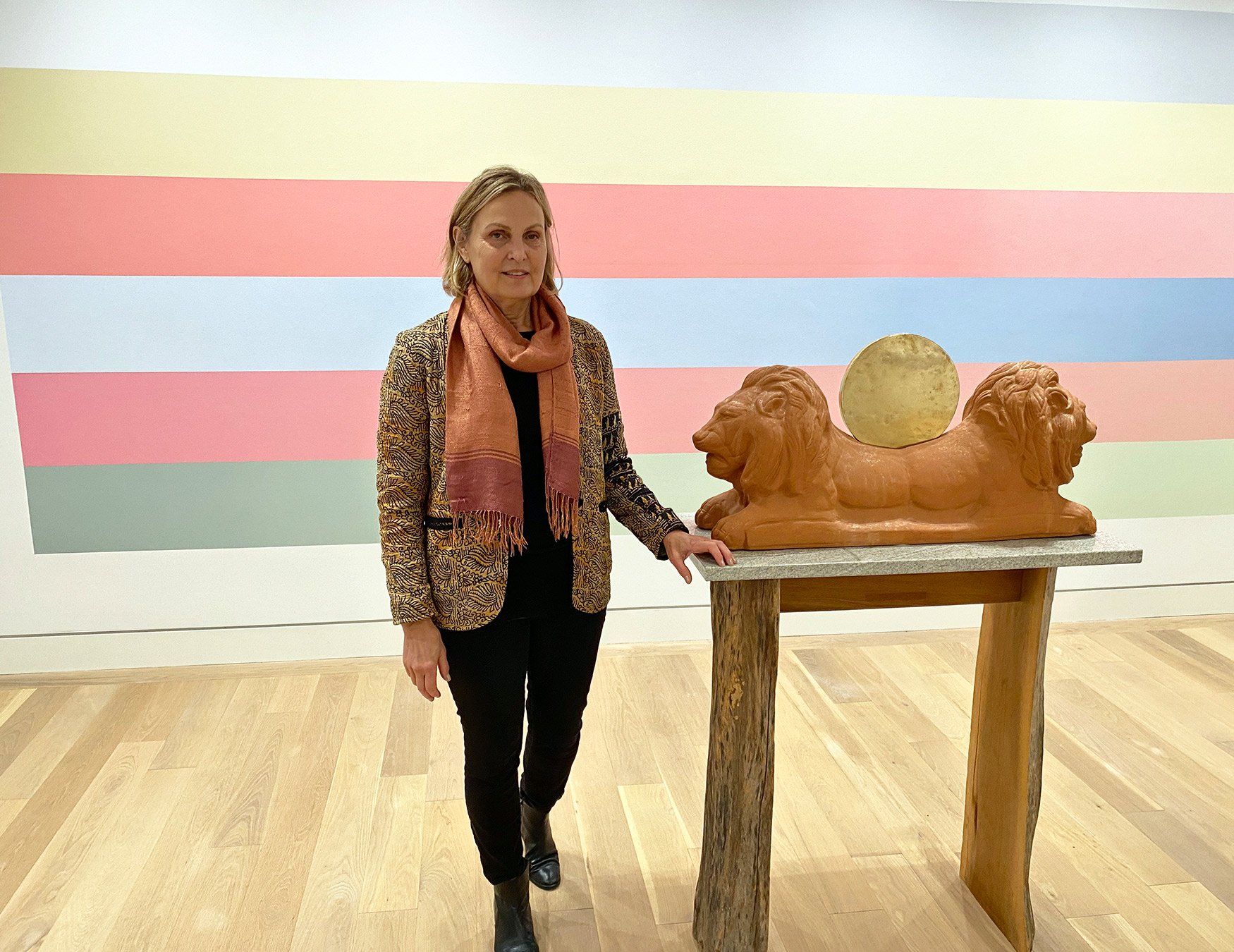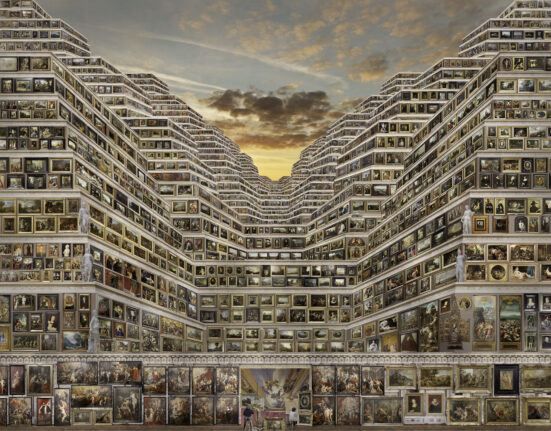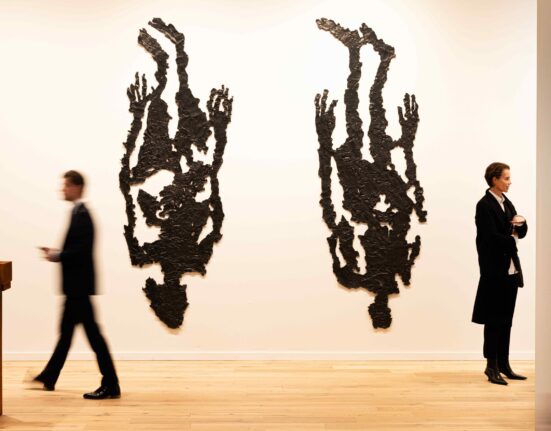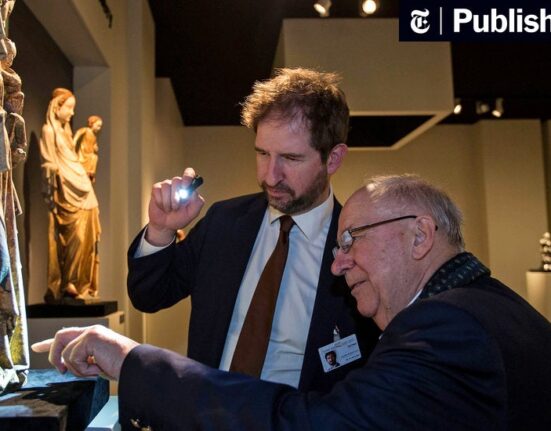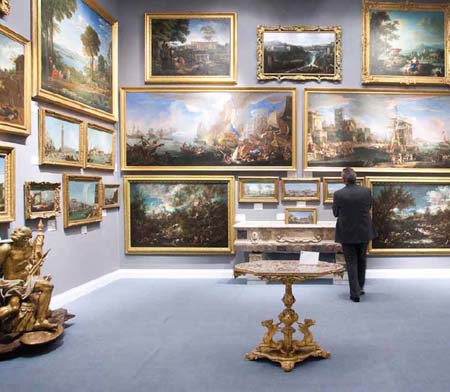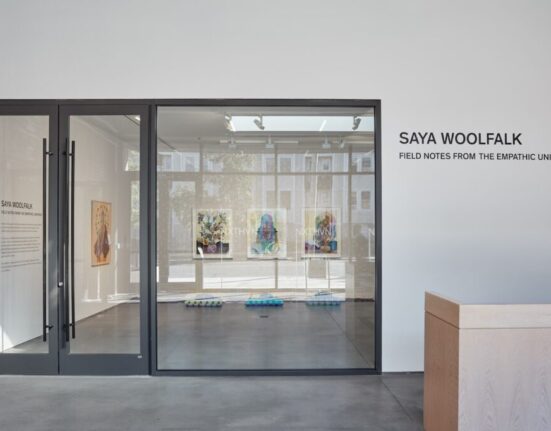Mary Boochever at her Guild Hall exhibition with “Lionheart,” foreground, and her site-specific mural “Inner Landscape, Epsilon Naught.”
Long before she was an artist, Mary Boochever was a “third-culture kid,” a term coined by a sociologist in the 1950s that has nothing to do with the arts. It refers to people who are raised abroad and later reintegrate into their country of origin.
Because her father was in the foreign service, “We moved every year or every two years, always abroad, except from when I was 7 until I was 10. That was the extent of my experience in the U.S. until I moved here as an adult.”
Ms. Boochever said during a conversation in her current Guild Hall exhibition, “Chart of the Inner Warp,” that she first became interested in making art as a teenager. Her family was living in Brussels, where she was introduced to Joan Aghib, a printmaker who ran an etching studio. She studied with Aghib and eventually became a studio assistant. “It was my first real introduction to an art community.”
When she was 18, her father retired and moved back to the United States, but by that time, she said, she felt “more European than American,” and went to live on her own in Germany. After submitting a portfolio of work from her time in Brussels, she was accepted into the Academy of Fine Arts in Munich, where she received both undergraduate and graduate degrees.
Arriving in New York City in 1979, she established a studio and began to exhibit her work. She had a solo show at PS1 in Queens, now MoMA PS1, in 1982, and early on a series of one-artist exhibitions at a small gallery in Manhattan.
“At that time, New York was kind of the hub of art activity. I was young, and a lot of opportunities opened to me. As an alien, the reintegration was difficult for me, but not in terms of art and career.” Informed that a Google search had turned up a glamorous 1983 photograph of her by Robert Mapplethorpe, she smiled and said quietly, “I’ve lived many lives.”
Recalling her time in Munich during a 2019 interview about her work in the Parrish Art Museum’s “Artists Choose Artists” show, Ms. Boochever said, “Like a lot of art students, I had a kind of crisis and wondered why I was doing anything at all, and decided that the thing that really motivated me was my interest in color.”
“I decided that if I was going to continue exploring color, then I was going to have to pursue the more mystical qualities of color.” She began learning about theosophy, alchemy, Kabbalah, feng shui, and anthroposophy, a spiritual movement founded in the early 20th century by Rudolf Steiner, a claimed clairvoyant who became well known as an educator.
All of those socio-religious philosophies “view color as a dynamic principle through which the life of the individual can be affected or transformed,” the artist said in an email. “Gradations are part of the language I use to depict the flow of energy in the human body, or to represent the cycle through the months of the year, as well as the seasons.”
Ms. Boochever’s work won Top Honors in Guild Hall’s 2019 Artist Members Exhibition, and the current exhibition is her reward. Its title, “Chart of the Inner Warp,” is one translation of the title of a Chinese Taoist painting, the “Neijing Tu,” which depicts the inner workings of the body as a landscape. Another translation is “Inner Landscape.”
“In the traditional Chinese medicine model,” she said, “the organs of the body exist in pairs, yin and yang. Each organ also has a color ascribed to it.”
Ms. Boochever has a chart of all the colors and the organs with which they are associated, and that chart is the point of departure for the four “Inner Landscape” paintings in the show. One, “Inner Landscape, Epsilon Naught,” is a monumental mural that took its creator eight days to paint on the gallery’s east wall.
The mural’s color gradations, she explained, “start with the lung, going into the large intestine, stomach, spleen, heart, small intestine, bladder, kidneys, pericardium, triple heater, gallbladder, and liver.” All the “Inner Landscape” paintings have the same pattern of movement, she said, but they express or explore different aspects of it.
While her first “Inner Landscape” works were numbered, more recently she has chosen letters from the Greek alphabet to differentiate them. “With Delta, you have a little bit of a landscape formation, a delta, while Gamma has to do with the saturation of color in your computer. Epsilon Naught has to do with electricity in the human body.”
At the same time, she said, all should be open-ended or suggestive, “not so much ‘this is this and that is that.’ A way to open the door to some other possibilities.”
In the exhibition, the mural provides a kind of horizon for “Lionheart,” a sculpture from 1997-99 that might at first seem an outlier. Ms. Boochever started with two lion sculptures, the kind that are common in garden-supply stores. “It’s a bit of an allusion to found objects.”
She sawed the two lions in half, glued them together, made a mold of the conjoined heads, and then cast it in terra cotta. The lion form, she said, refers to an Egyptian amulet intended to link its owner with renewal and regeneration. A brass disc represents the sun. Color figures into the work as well: A red lion has significance in alchemy, and in ancient Egypt, the lion was made from red material.
The exhibition also includes two shaped canvases, “Orea” (2019), the prizewinning work from 2019, and “Donacon” from 2023.
The inspiration for the works in that series, said the artist, came from a book about the myths and legends associated with wells and springs in the ancient world. The titles refer to those locations, and their shapes reflect the idea that “there’s a land mass, and it’s joining a water mass. I’m very interested in the place where the two meet, but also in this idea that the land could represent the masculine and the water the feminine.”
Ms. Boochever moved to the East End in 1993, the same year she married the artist Kevin Teare, who was himself the winner, in 2007, of Guild Hall’s Artist Members Exhibition. They lived in Bridgehampton at first, then in Hampton Bays for 10 years, and are now happily settled in Noyac.

